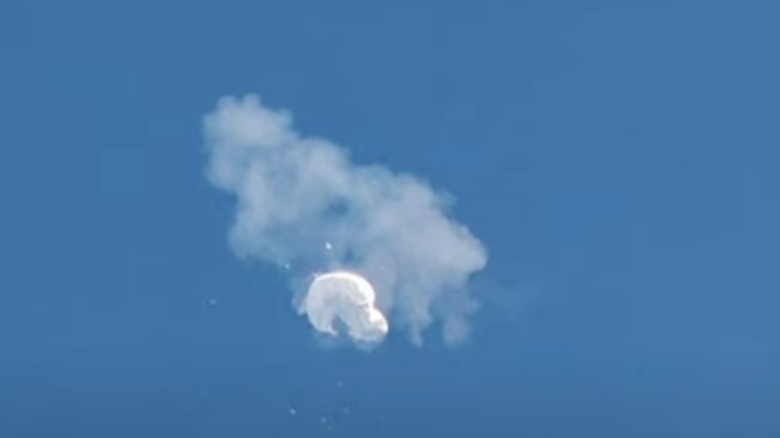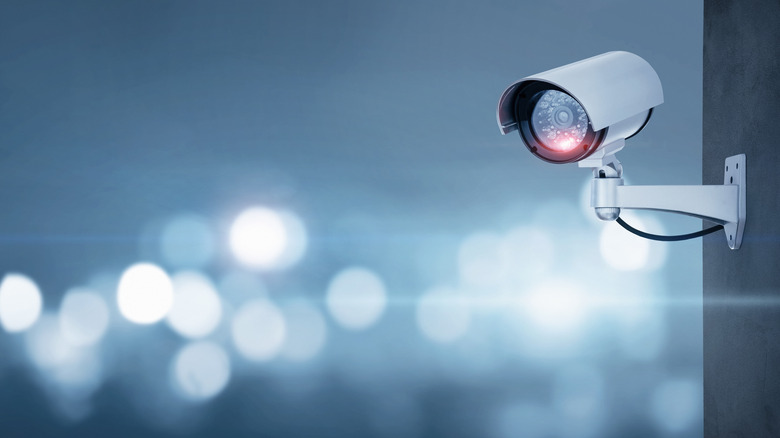What Does A Spy Balloon Really Do?
In early February 2023, The Conversation reported that the U.S. military destroyed a Chinese spy balloon off the coast of South Carolina. Per Al Jazeera, the balloon, the size of three school buses, traveled from Alaska to Canada and back through — and across — mainland United States. The New York Times writes that the Biden administration believes China launched the balloon to gather intel on military sites in the country. Although China acknowledges the balloon is theirs, they denounced its annihilation and noted that the balloon intended to collect weather data (via CNBC). But what exactly is a spy balloon? To no surprise, its name reveals all.
According to Sky News, a spy balloon is a gas-filled device with cameras and other surveillance instruments tethered to it. Time explains that spy balloons are nothing new, and have been used throughout history and during various conflicts, including the Franco-Austrian war, the Civil War, World War I, World War II, and the Cold War. USA Today notes that during the Civil War, for example, hot air balloons were used by the Union to trail Confederate forces. Against all odds, spy balloons are making a comeback in a big way.
The benefits of using a spy balloon
Marina Miron, a defense researcher at King's College London, told USA Today that spy balloons use technology such as cameras to "observe sights of interest and gather data." The Guardian writes that spy balloons can go up to 80,000 to 120,000 feet and can utilize solar power and radar. Likewise, The Conversation adds that spy balloons primarily use wind and weather patterns to navigate the air. However, the spy balloon that the United States recently shot down used a different innovation — propellers. Having said that, the publication notes that there is a reason why the Chinese may have opted to use an air balloon rather than an advanced satellite.
According to Al Jazeera, balloons can provide more intelligence than a satellite. Ultimately, they can take better photos because they are closer to the ground. Moreover, the spy balloon likely has various attached cameras with zoom or infrared that can obtain more information. David DeRoches, a professor at National Defense University, told Al Jazeera that intelligence agencies could also use spy balloons in "gathering electronic signals" to interfere with communication.
Per Sky News, defense expert Michael Clarke explained, "The advantage is they can stay in one place for a long time." He added, "Because of the way the Earth rotates, unless a satellite is over the Equator, you need three to five satellites going all the time to track the same spot." Clarke said, "These balloons are also relatively cheap, and much easier to launch."
The future of spy balloons
Although spy balloons might seem antiquated, Time writes they are here to stay. In 2022, Tom Karako, a Missile Defense Project director at the Center for Strategic and International Studies, told Politico that spy balloons have much to offer to the United States. He said, "They can be trucks for any number of platforms, whether it be communication and datalink nodes, ISR, tracking air and missile threats, or even various weapons — and without the predictable orbits of satellites." In fact, the publication notes that the Pentagon was planning to spend over $23 million on spy balloons in 2023.
Per Sky News, this is only the beginning of using balloons for this purpose. The Guardian reports that John Blaxland, professor of international security and intelligence studies at the Australian National University, has a similar sentiment. He stated, "There's no limit to what kind of technology you can stick at the bottom of the balloon."
Blaxland went on to say, "With space now being so congested and contested and now so vulnerable, that sub-space domain, the upper atmospheric domain, has developed a whole new utility and importance for international surveillance and espionage that we had thought was passed and is obviously back, center stage." Despite this, Scientific American points out that spy balloons are relatively hard to control and can really only do so much.


